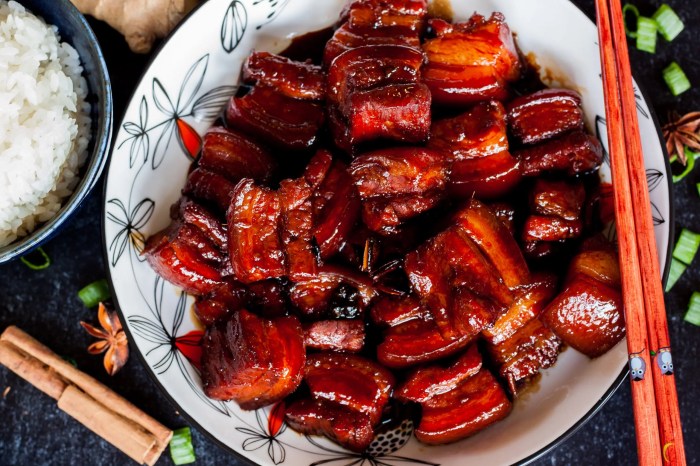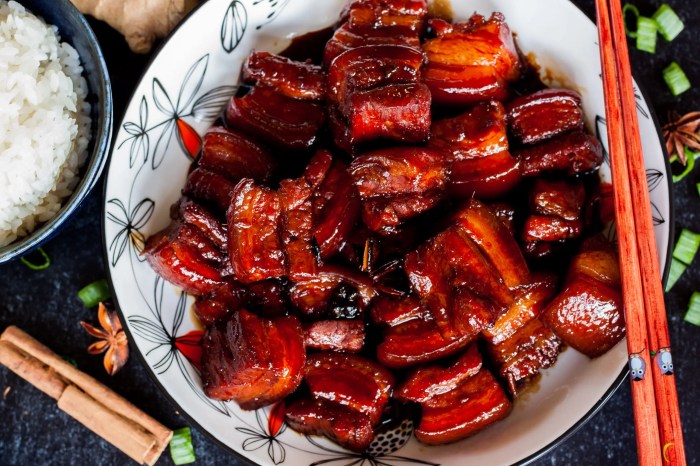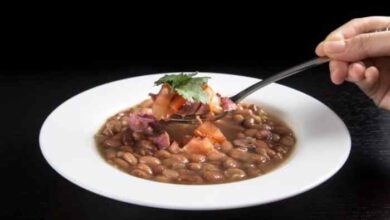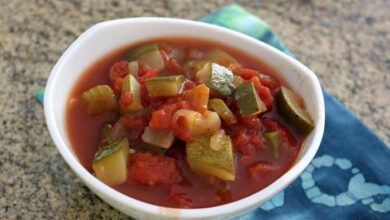
Slow Cooked Red Braised Pork Belly: A Culinary Journey
Slow cooked red braised pork belly, a dish that conjures images of tender, melt-in-your-mouth meat bathed in a rich, savory sauce. This culinary masterpiece has captivated taste buds for centuries, its origins lost in the mists of time, but its appeal undeniable.
From the humble beginnings of peasant kitchens to the refined tables of emperors, this dish has transcended cultures and continents, leaving a lasting legacy of flavor and comfort.
The magic of slow cooking unlocks the full potential of the pork belly, transforming tough, fatty cuts into a symphony of textures and flavors. As the meat simmers gently in a flavorful broth, collagen breaks down, rendering the belly incredibly tender, while the fat renders, creating a rich, luscious sauce that coats the meat with an irresistible sheen.
The Allure of Slow-Cooked Red Braised Pork Belly
The aroma of slow-cooked red braised pork belly, a symphony of sweet, savory, and umami notes, has the power to transport you to a realm of culinary bliss. This dish, a testament to the magic of time and heat, is more than just a meal; it’s an experience.
Imagine a crisp autumn evening, the air tinged with the scent of cinnamon and star anise, as you savor a tender, melt-in-your-mouth pork belly, its rich sauce clinging lovingly to its surface. This is the essence of slow-cooked red braised pork belly.This dish is a culinary masterpiece, a harmonious blend of ancient techniques and modern innovation.
Its origins can be traced back to ancient Chinese cuisine, where slow cooking was a necessity, a way to tenderize tough cuts of meat using the gentle heat of a wood-fired stove. Over time, the dish evolved, incorporating regional variations and new ingredients, culminating in the diverse and delicious red braised pork belly we know today.
Characteristics of Slow-Cooked Red Braised Pork Belly
Slow-cooked red braised pork belly is a dish defined by its unique characteristics. The slow cooking process, typically lasting several hours, transforms the tough, fatty pork belly into a tender, succulent masterpiece. The red braising liquid, a complex concoction of soy sauce, sugar, spices, and often wine, imparts a rich, savory flavor and a deep, alluring red hue.
The result is a dish that is both visually stunning and incredibly satisfying.
Slow cooked red braised pork belly is a dish that requires patience, but the reward is truly worth it. The tender, melt-in-your-mouth pork belly is a symphony of flavors, and it’s the perfect dish for a cozy night in. I recently discovered a fantastic deal on a m kitchen world silicone spatula set sale amazon that’s perfect for stirring the braising liquid and ensuring that every piece of pork belly is evenly coated in the delicious sauce.
The silicone spatulas are heat-resistant and non-stick, making them ideal for handling this flavorful dish.
Key Characteristics:
- Tenderness:The slow cooking process breaks down the tough collagen in the pork belly, resulting in a melt-in-your-mouth texture.
- Flavor:The red braising liquid infuses the pork belly with a complex and delicious flavor profile, balancing sweet, savory, and umami notes.
- Richness:The pork belly itself is naturally fatty, contributing to the dish’s richness and mouthfeel.
- Versatility:Slow-cooked red braised pork belly can be enjoyed in various ways, from a simple rice bowl to a gourmet dish.
Ingredients and Preparation
The magic of red braised pork belly lies in the perfect blend of ingredients, each playing a crucial role in creating a symphony of flavors. From the tender pork belly to the aromatic spices, every component contributes to the dish’s rich and complex character.
Essential Ingredients
The ingredients list for a traditional red braised pork belly recipe is relatively simple, but each component is essential for achieving the desired flavor profile.
- Pork Belly:The star of the show, the pork belly provides the richness and tenderness that defines this dish. Look for a piece with a good amount of fat, as this will render down during the braising process, adding incredible flavor and moisture to the meat.
- Soy Sauce:The base of the braising liquid, soy sauce provides a salty and umami depth to the dish. Use a high-quality soy sauce for the best results.
- Rock Sugar:This adds a touch of sweetness and helps to balance the savory flavors of the soy sauce and other ingredients.
- Shaoxing Wine:A Chinese rice wine, Shaoxing wine adds a subtle sweetness and complexity to the braising liquid. It also helps to tenderize the pork belly.
- Star Anise:A fragrant spice with a licorice-like flavor, star anise adds a warm and complex aroma to the dish. It also helps to balance the sweetness of the rock sugar.
- Cinnamon Sticks:These provide a warm and spicy flavor to the braising liquid, complementing the star anise and creating a well-rounded aroma.
- Dried Chili Peppers:These add a touch of heat to the dish, balancing the sweetness and richness of the other ingredients.
- Ginger:This adds a pungent and slightly sweet flavor to the dish, helping to balance the richness of the pork belly and the savory flavors of the other ingredients.
- Garlic:This adds a pungent and aromatic flavor to the dish, complementing the ginger and creating a complex flavor profile.
- Scallions:These add a fresh and slightly sweet flavor to the dish, providing a welcome contrast to the richness of the pork belly and the savory flavors of the other ingredients.
Preparing the Pork Belly, Slow cooked red braised pork belly
Before braising, the pork belly needs to be prepared properly to ensure optimal results.
- Score the Pork Belly:Using a sharp knife, score the fat layer of the pork belly in a crosshatch pattern. This helps the fat to render down more evenly during the braising process, resulting in a more tender and flavorful dish.
- Marinate the Pork Belly:Combine the soy sauce, Shaoxing wine, rock sugar, star anise, cinnamon sticks, dried chili peppers, ginger, garlic, and scallions in a bowl. Stir well to ensure the ingredients are evenly distributed. Place the scored pork belly in a large container or resealable bag and pour the marinade over it.
Make sure the pork belly is completely submerged in the marinade. Refrigerate for at least 2 hours, or up to overnight, to allow the flavors to penetrate the meat.
Cooking Techniques
The magic of slow-cooked red braised pork belly lies in the gentle transformation of tough cuts into melt-in-your-mouth tenderness. This process is all about low and slow cooking, allowing time for the flavors to meld and the meat to become incredibly succulent.
The Art of Low and Slow Cooking
Low and slow cooking is the key to unlocking the full potential of pork belly. By cooking at a low temperature (around 275°F or 135°C) for an extended period (typically 3-4 hours), the collagen in the meat breaks down into gelatin.
Slow cooked red braised pork belly is a dish that requires patience, but the reward is truly worth it. The tender, melt-in-your-mouth pork is infused with rich, savory flavors that are simply irresistible. For a lighter option, you could try Anne’s fabulous grilled salmon , but for pure indulgence, there’s nothing quite like a plate of slow cooked red braised pork belly.
This process results in a tender, juicy, and flavorful final product. The slow cooking also allows the braising liquid to penetrate the meat, infusing it with rich and complex flavors.
The Role of the Braising Liquid
The braising liquid plays a crucial role in the success of this dish. It acts as a flavorful bath that tenderizes the meat and imparts its unique character to the pork belly. A combination of liquids, such as broth, wine, soy sauce, and spices, is typically used to create a rich and complex braising liquid.
Slow cooked red braised pork belly is a dish that always brings back fond memories of family gatherings. The tender, melt-in-your-mouth pork is simply divine. It’s a dish that reminds me of another classic comfort food, a retro ground beef casserole with biscuits , which I used to have as a kid.
Both dishes are so satisfying and nostalgic, and I can’t help but feel a sense of warmth and contentment whenever I enjoy them.
The braising liquid should be enough to cover the pork belly completely. As the meat cooks, the liquid reduces and intensifies, creating a luscious sauce that can be spooned over the finished dish.
Variations and Flavor Profiles
The beauty of red braised pork belly lies in its adaptability. The basic recipe serves as a canvas upon which you can paint vibrant flavor profiles, incorporating regional influences and personal preferences. This versatility allows for endless possibilities, transforming the dish from a comforting classic to a culinary adventure.
Regional Variations
Regional variations in red braised pork belly recipes often reflect the unique ingredients and culinary traditions of a particular area. For example, in the southern regions of China, where fermented black beans are a staple, they are frequently incorporated into the braising liquid, lending a savory and umami-rich depth to the dish.
In contrast, in the northern regions, where spices like star anise and cloves are commonly used, these ingredients are often added to the braising liquid, resulting in a more aromatic and complex flavor profile.
Flavor Profiles
The flavor profile of red braised pork belly can be tailored to your liking through the use of various spices, sauces, and aromatics.
Spices
Spices play a crucial role in shaping the flavor profile of red braised pork belly.
- Star Anise: Adds a sweet, licorice-like flavor, commonly used in Chinese cuisine.
- Cinnamon: Contributes warm, sweet, and slightly spicy notes, adding complexity to the dish.
- Cloves: Provides a strong, pungent flavor, often used in combination with star anise and cinnamon.
- Black Peppercorns: Offers a sharp, peppery flavor, adding a touch of heat to the dish.
- Sichuan Peppercorns: Adds a unique, tingling sensation, characteristic of Sichuan cuisine.
Sauces
Sauces enhance the flavor and richness of the braising liquid.
- Soy Sauce: Provides a salty, savory flavor, essential for red braising.
- Oyster Sauce: Adds a umami-rich, slightly sweet flavor, often used in Chinese cuisine.
- Hoisin Sauce: Offers a sweet, savory, and slightly tangy flavor, commonly used in Cantonese cuisine.
- Fish Sauce: Contributes a salty, savory, and umami-rich flavor, often used in Southeast Asian cuisine.
- Sweet Chili Sauce: Adds a sweet, spicy, and tangy flavor, often used in Thai cuisine.
Aromatics
Aromatics enhance the fragrance and depth of flavor in the braising liquid.
- Ginger: Adds a pungent, slightly sweet flavor, often used in combination with garlic.
- Garlic: Provides a strong, pungent flavor, often used in combination with ginger.
- Shallots: Offer a sweet, slightly pungent flavor, adding complexity to the dish.
- Scallions: Contribute a mild, onion-like flavor, often used as a garnish.
- Lemongrass: Adds a citrusy, grassy flavor, often used in Southeast Asian cuisine.
Flavor Profile Examples
| Variation | Key Ingredients | Flavor Profile |
|---|---|---|
| Classic Chinese Red Braised Pork Belly | Soy sauce, rock sugar, star anise, cinnamon, cloves, ginger, garlic | Savory, sweet, aromatic, and slightly spicy |
| Sichuan Red Braised Pork Belly | Soy sauce, rock sugar, Sichuan peppercorns, ginger, garlic, fermented black beans | Spicy, savory, and slightly sweet with a tingling sensation |
| Thai Red Braised Pork Belly | Fish sauce, palm sugar, lemongrass, galangal, kaffir lime leaves, chilies | Savory, sweet, tangy, and spicy with a citrusy, grassy aroma |
Serving Suggestions and Accompaniments
Red braised pork belly, with its rich, succulent flavor and tender texture, calls for accompaniments that complement its decadence and provide a balanced dining experience. The best side dishes are those that offer contrasting textures and flavors, cutting through the richness and highlighting the nuances of the pork.
Traditional Pairings
The choice of accompaniments often reflects the cultural and regional influences of the dish. For example, in Chinese cuisine, red braised pork belly is frequently served with steamed rice, providing a neutral canvas for the bold flavors. The rice absorbs the savory sauce, creating a delightful combination.
In addition to rice, steamed buns (bao) are a popular choice, especially in Northern China. The soft, pillowy buns act as vessels for the tender pork, offering a delightful textural contrast.
Serving Suggestions and Flavor Profiles
Here’s a table that highlights different serving suggestions and their accompanying flavor profiles:
| Serving Suggestion | Flavor Profile | Cultural Influence |
|---|---|---|
| Steamed Rice | Neutral, absorbs the savory sauce | Chinese |
| Steamed Buns (Bao) | Soft, pillowy, contrasting texture | Chinese |
| Stir-fried Greens | Fresh, crisp, contrasting texture | Various |
| Pickled Vegetables | Tangy, acidic, balances the richness | Various |
| Mashed Potatoes | Creamy, smooth, complements the richness | Western |
| Green Salad | Fresh, light, adds a refreshing element | Western |
Culinary Benefits and Nutritional Value: Slow Cooked Red Braised Pork Belly

Slow-cooking pork belly offers a unique culinary experience, transforming this humble cut into a tender, flavorful delicacy. The long, gentle cooking process allows the fat to render and the meat to break down, resulting in a melt-in-your-mouth texture that is simply unmatched.
Beyond its culinary allure, slow-cooked pork belly also boasts a surprisingly impressive nutritional profile.
Nutritional Value of Slow-Cooked Pork Belly
Pork belly is a good source of protein, essential vitamins, and minerals. A 3.5-ounce serving of cooked pork belly provides approximately:
- 20 grams of protein
- 150 calories
- 10 grams of fat
- 1 gram of carbohydrates
- Good source of thiamin, niacin, and vitamin B12
- Contains iron, zinc, and potassium
It is important to note that the nutritional value of pork belly can vary depending on the cooking method and ingredients used. Slow-cooking, however, can help to enhance the nutritional value of pork belly by breaking down the connective tissues and making the nutrients more readily available.
Comparison to Other Cooking Methods
Slow-cooking offers several advantages over other cooking methods in terms of both culinary benefits and nutritional value. Compared to frying or grilling, slow-cooking:
- Reduces the amount of fat content by allowing the fat to render out.
- Preserves more nutrients by avoiding high heat exposure.
- Produces a more tender and flavorful result due to the slow breakdown of connective tissues.
While other cooking methods may be quicker, slow-cooking provides a healthier and more flavorful alternative.






